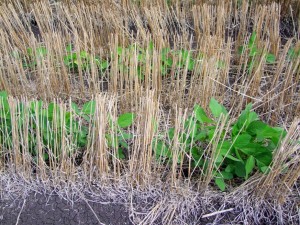Experimentation with reflective surfaces in horticulture to repel aphids have been carried out in many parts of the world. Reflective mulches reduce landing rates of aphids with materials such as aluminum foil and white polythene proving effective repellents.
Reflective mulches were also found to be most effective when both sides of the row were covered in mulch opposed to just one side.
Such practices are not practical for broad-acre crops. However, standing stubble can also provide a reflective surface and may hence reduce aphid infestations. Wide row spacing will be more effective in repelling aphids than narrow rows.
While there is currently no data available on the effect of stubble on aphid numbers in broad acre crops – it may be a worthwhile exercise in those regions where aphids are a major pest.
While most observations with reflective surfaces have focused on aphids, reflective surfaces may also deter other pests. Soybeans planted in standing stubble in Queensland were less susceptible to etiella damage compared to soybeans planted in conventionally cultivated fields. Stubble made the crop, at least in the earlier vegetative stages, less visible to the etiella. Initial observations suggest that this approach has potential, with 100% of soybean plants damaged by etiella in a conventional planting, as opposed to only 17% infested in a nearby crop planted into standing wheat stubble.
Further information
Insect reactions to light and its applications to pest management (Shimoda, M. & Honda, K. Appl Entomol Zool (2013) 48: 413. doi:10.1007/s13355-013-0219-x)
Rice Stubble and Straw Mulch Suppression of Preflowering Insect Pests of Cowpeas Sown After Puddled Rice (Environmental Entomology 1984 – pdf)

